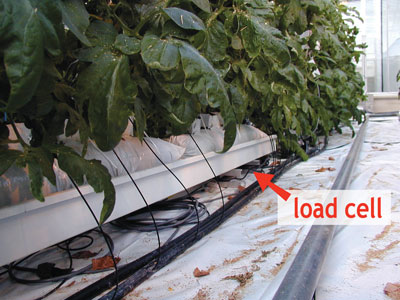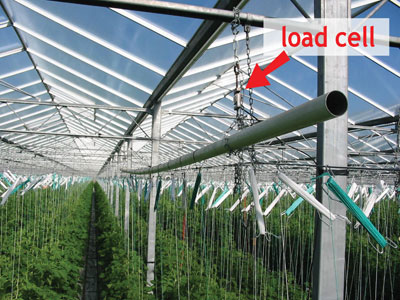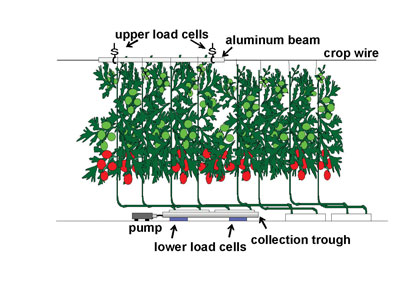
Automated crop monitoring provides numerous benefits to greenhouse operators, Dr. David Ehret, of the Pacific Agri-Food Research Centre in Agassiz, B.C., told growers attending the annual Saskatchewan Green Trades Conference.
Automated crop monitoring provides numerous benefits to greenhouse
operators, Dr. David Ehret, of the Pacific Agri-Food Research Centre in
Agassiz, B.C., told growers attending the annual Saskatchewan Green
Trades Conference.
He said it is relatively inexpensive, easy to expand, highly flexible,
simple, and reliable. The procedure also provides an early warning
system, allows comparison of different zones, seasons and years, and
continually gathers information on crop conditions.
 |
|
| Dr. David Ehret of the Pacific Agri-Food Research Centre of Agriculture and Agri-Food Canada. |
|
 |
|
| The lower load cell. (Photo courtesy of T. Helmer) |
|
 |
|
| The upper load cell. (Photo courtesy of T. Helmer) | |
 |
|
| An overview of the crop monitoring system. (Drawing courtesy of Dr. David Ehret) |
Dr. Ehret provided an overview of the research he and his colleagues
have conducted. “Our goal was to develop a system that would
continuously and automatically record water use and growth in
greenhouse vegetable vine crops (tomatoes, cucumbers and peppers).”
The researchers were trying to create a system that is non-invasive and
integrates with current greenhouse crop management practices, requires
minimal maintenance, monitors groups of plants to reduce variations
within the crop and provides information for growers which they
wouldn’t be able to obtain in any other way.
The system that Dr. Ehret and his research team developed uses two sets
of load cells (scales). The lower set measures water uptake
(transpiration), number of irrigation events, emitter feed volume,
drain volume and per cent over-drain, along with media weight and per
cent media moisture. The upper set measures changes in canopy weight or
crop growth, the weight of the harvested fruit, and the weight of the
prunings. The degree of water stress that the plants might be
experiencing can also be estimated.
The researchers also experimented with light and weight-based
irrigation and found that weight-based over-drain is more consistent
through the day.
In potted plants, Dr. Ehret noted, load cells measure crop water use, crop growth and changes in substrate moisture.
He also touched on the measurement of starch in leaves to help manage
CO2 dosing, as well as the detection of special plant odours which may
indicate insect problems. He noted that those systems are still under
development and are not ready for public sale yet.
Computer integration is relatively easy for water use and canopy
temperature data, but more difficult for growth data. “Predictive
models are still being developed,” said Dr. Ehret.
Myron Love is a freelance writer and photographer in Manitoba.
Print this page